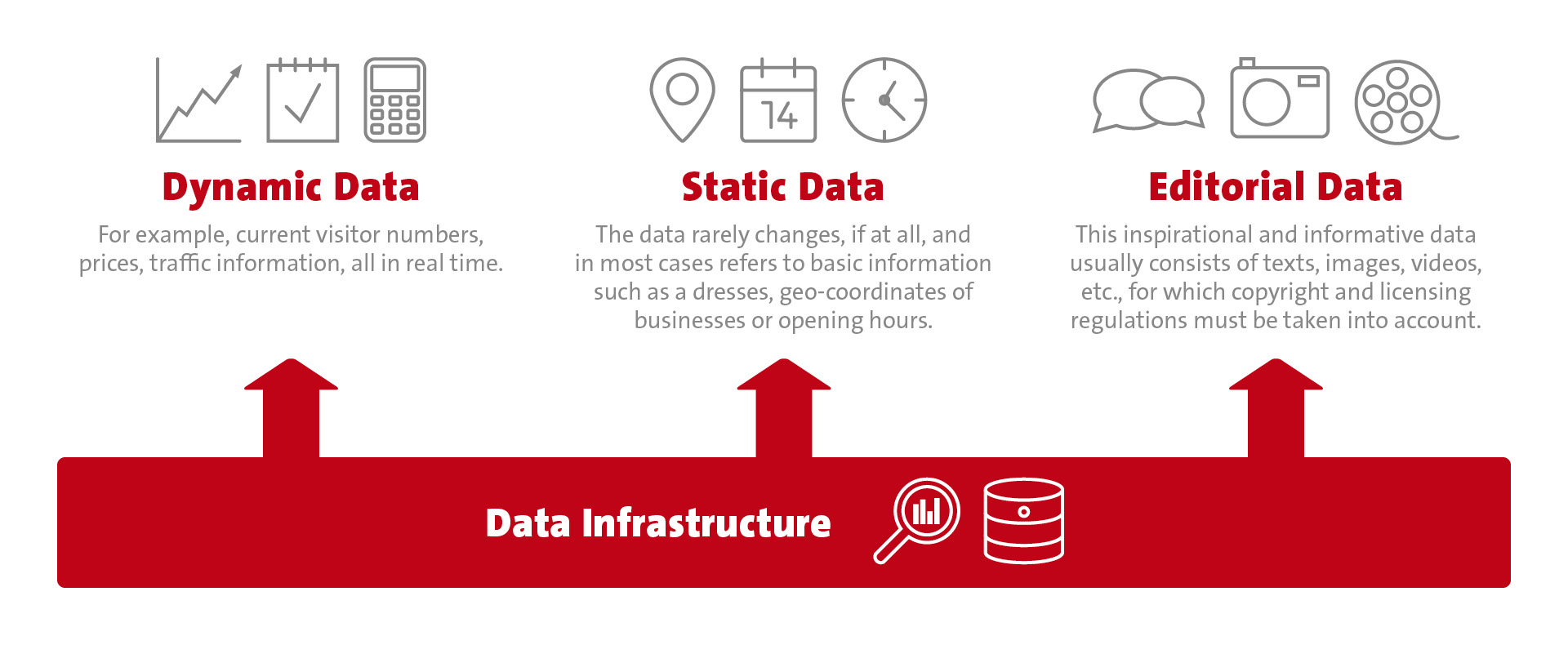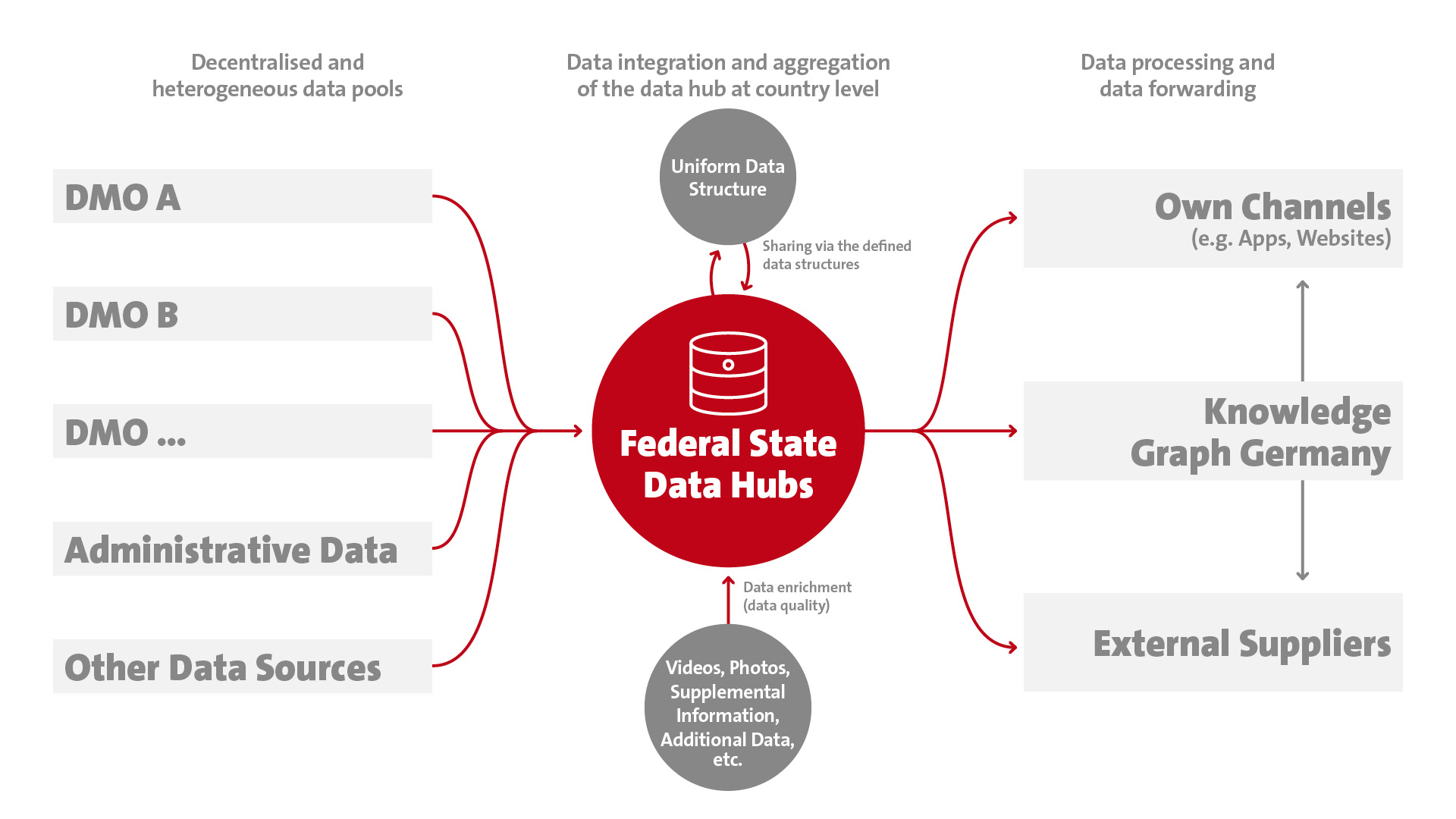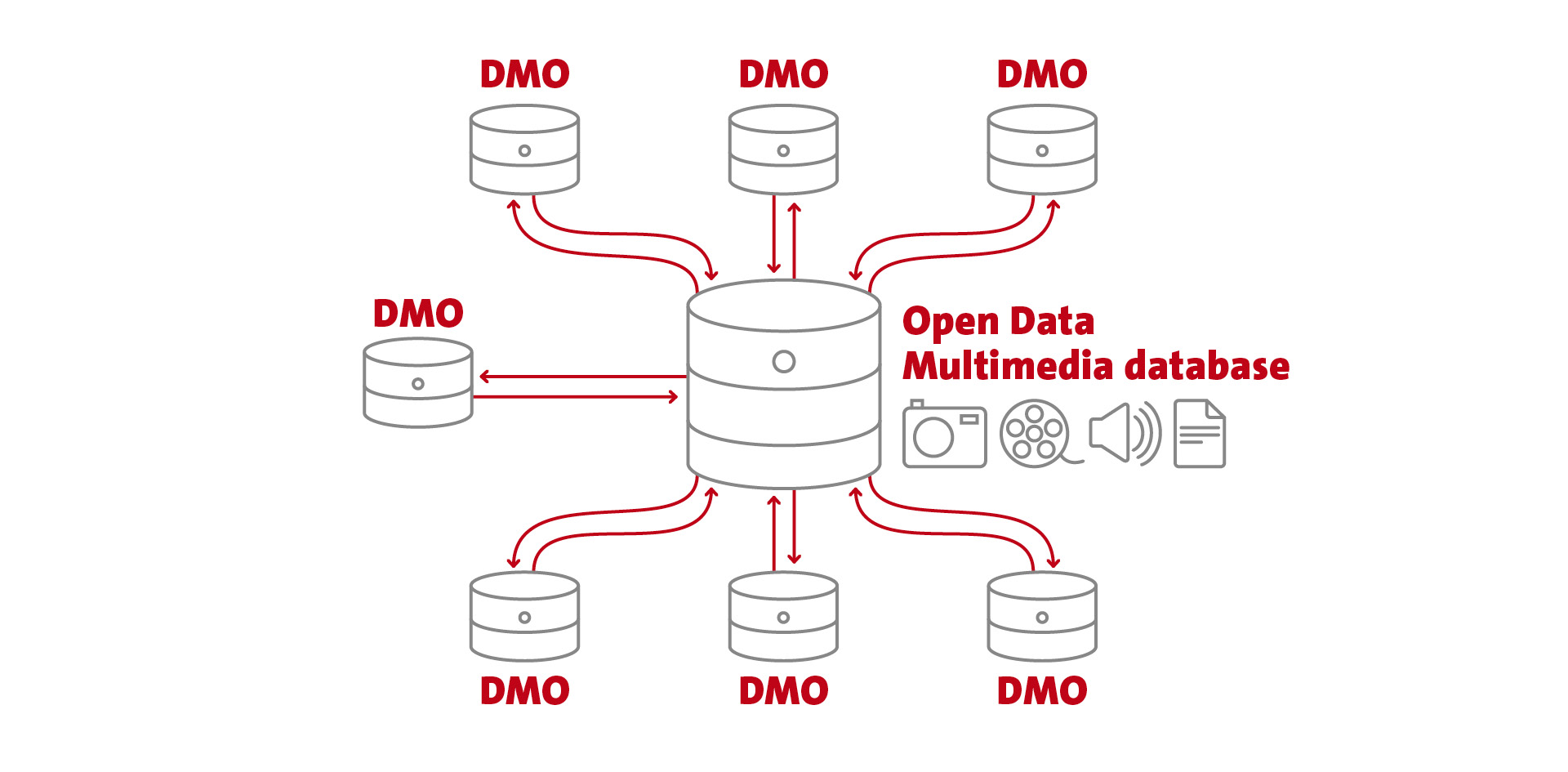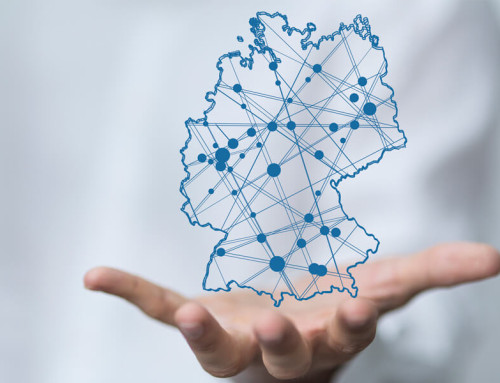The foundation of the digital destination.
Data infrastructure is the foundation on which a digital destination can build. The quality of the data determines how digital applications can be used in conjunction with the digital equipment in the destination. An Infoscreen in a tourist information is only as good as the data quality offered to the guests.
High data quality should therefore be seen as a reference for the digital maturity of the destination. The DMOs must therefore ensure that all tourism-relevant data, such as information on POIs, events, prices or opening times of excursion destinations, can reach the guests on all channels. The quality of the data infrastructure determines how well or poorly the destination is perceived digitally by guests. To achieve a good result here, it is necessary that data is processed in a certain way.
The data infrastructure is the foundation on which digital applications and digital equipment in the destination are built.
Requirements for a Digital Data Infrastructure
A digital data infrastructure places various requirements on the data that is to be made available to guests. In essence, seven criteria must be met:
Digital Applications for Data Playout
The data should be processed in a way that it can be played out independently of the output channel.
The requirements for data can often only be achieved with the corresponding effort. Rarely are they already available in such a way that they immediately meet all conceivable requirements of their own and external output channels. It is therefore important for the DMO to know which data is already available, where and in which quality, and what added value it offers. Priorities are then set in the processing of the data. It therefore makes sense to link the increase in data quality to concrete digital use cases – such as the presentation of all hiking routes in a region for specific groups of guests. Nevertheless, the goal remains that the data can continue to be used regardless of the output channel in order to create the highest possible visibility. Data quality and data architecture are thus the focus when establishing a digital data infrastructure.
If data is maintained uniformly and prepared in a high-quality manner, digital services can be established for this purpose. These applications can be enriched with data from all stakeholders and can also be used by all. Examples of such applications are widgets that provide location-specific information and can be used, for example, by hotels or tourist information offices to offer a range of information directly at the location on a touch screen. Integration into the respective website is also possible in order to offer guests excursion tips in the region – without having to maintain the data yourself.
In addition, it should be possible to pass on the data to external service providers in order to achieve the highest possible visibility. In addition, the GNTB’s collaborative Open Data project, the LMO and Magic Cities were to receive the data.
Data preparation can be linked to concrete digital applications that can be personalised and shared by stakeholders in a region.
Data Integration and Data Flow
The development of modern digital services requires the integration of different data sources. Within an application, external data sources such as maps and current weather reports are usually the basis on which further functions are built that require additional data. For instance, the data of public administrations such as the mapping of public toilets, bathing places, avenues and much more can be helpful here. The quality of the data can vary greatly from region to region, which is why an analysis of the data stock and an exchange with the actors who hold the data are highly recommended. But also global projects like the Linked Open Data Cloud or Wikipedia sometimes hold very good data sets that can be used.
When integrating the data, the primary objective is to structure them in a consistent way and to fill in missing information so that their quality is largely homogeneous. In the course of the integration, special features and necessary additions regarding the labelling of the data and their quality become visible. Here, it is then a matter of enhancing those data records that are not yet of satisfactory quality – for example with photos of the most popular bathing spots.
In addition, existing schemas on which the database structures are based can be extended. If, for example, the existing “Beach” scheme does not yet provide for the designation of dog or nudist beach sections, this should be amended. The first step is to research whether there have already been corresponding extensions to the respective scheme in other federal states and whether they can be built upon. Appropriate tools will be made available for this purpose in the future. The communication for this is done via this website.
In the course of data preparation, existing schemes can be added so that they can be adapted to the needs of the respective region.
Clear Responsibilities for Data Management
The coordination of these processes requires clear responsibilities. Here it is helpful to differentiate between the four levels of service providers (1.), localities (2.), regions and cities (3.) and federal state (4.). In addition, the GNTB’s initiative has created a federal level.
- Hosts and other tourist businesses: They are required to maintain basic data such as opening hours or geo-coordinates, which they should already be doing anyway for Google visibility.
- Location level: Within a location, the basic data of the local points of interest (POI) should be maintained, so that these public attractions can also be digitally mapped.
- Regions and cities: At this level, the focus should be on cross-local content such as routes and tours for walkers and cyclists.
- State level: The state is in close contact with the Open Data project and therefore coordinates the processes. From here, impulses can be passed on to the other levels. The state can also support them, for example by providing inspirational data such as photos and videos.
When defining the responsibilities, it is important that there is only one responsibility for the respective data. In addition, it must be determined in which system exactly the data is entered and how it can then be further used. The aim is to use synergies and avoid redundant data maintenance.
When managing data, it should be clearly defined who manages which data in order to avoid redundancies and to use synergies.
To eliminate redundant data sets (duplicates) and to establish a quality check of the data, heuristics can be developed that help to select the data set that is better. If different information on the same object is better maintained in different data records, it is advisable to merge them. Those records that do not meet predefined minimum requirements are not even transferred into the system. To ensure that these minimum standards are met, mandatory and optional data fields may also be defined.
The aim is to establish a complete and up-to-date database that can be used for distinct applications as well as for the transfer into a knowledge graph for German tourism. From there, the data can then be retrieved and used for any applications needed for the destinations. The advantage of this is that data no longer has to be aggregated individually for each application, but is already available to all tourism stakeholders, appropriately processed and centralised at the German level.
An Open Multimedia Database
The high-quality and comprehensive preparation of data such as photos, videos or podcasts can be a challenge. At state or regional level, a database system is recommended for this purpose, in which multimedia content is kept in bundles. It is important that the metadata of the media content is also described in such a database using schema.org. In addition to the license (Creative Commons, Open Content and others), this also includes geo-coordinates, title and description of the video or image, the copyright holder, etc. In this way, the media content is machine-readable and the conditions for further use are clearly defined. The metadata is then available in a form compatible with the Knowledge Graph of German Tourism and can be integrated there with links to the media files.
Such a database can be seen as a service that offers the possibility for service providers and at the local level to access a variety of different (multimedia) contents and also to use them for their own channels. At the same time, own content can be entered there so that it receives a higher distribution. Partners can access the database directly via a client function and also use it as a platform for their own data if required. Ideally, an integrated solution from a technical service provider is used for this purpose, so that in addition to the media content, all other data, e.g. on events or POIs, is also consolidated, thus directly avoiding the duplicate maintenance of data records and redundancies and making use of synergies. When setting up such a system, care must be taken to ensure that questions of use and liability are clearly regulated in advance and during operation, so that joint use is possible without disruption. The provision of high-quality multimedia content also has a direct additional benefit in search engines, since open and fully awarded media content increases visibility in Google and the like.
Eric Horster
West Coast University of Applied Sciences
Eric Horster ist Professor an der Fachhochschule Westküste im Bachelor- und Masterstudiengang International Tourism Management (ITM) mit den Schwerpunktfächern Digitalisierung im Tourismus und Hospitality Management. Er ist Mitglied des Deutschen Instituts für Tourismusforschung.
Mehr zur Person unter: http://eric-horster.de/
Elias Kärle
University of Innsbruck
Elias Kärle ist Wissenschaftler an der Universität Innsbruck. In seiner Forschung beschäftigt er sich mit Knowledge Graphs, Linked Data und Ontologien. Als Vortragender referiert er meist zur Anwendung und Verbreitung semantischer Technologien im Tourismus.
Mehr zur Person unter: https://elias.kaerle.com/

















